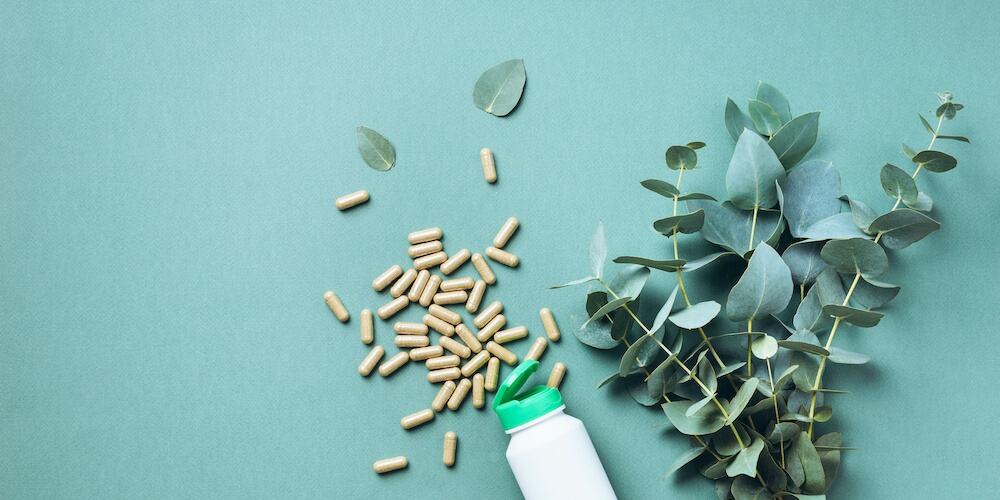What are the benefits of quercetin?
A natural molecule
Quercetin is a pigment belonging to a group of plant compounds called flavonoids.
It is extracted from various plant sources, and is found in a wide variety of foods.
It is found in fruits (apples, red or black berries, cherries), in vegetables (onions, peppers, spinach, broccoli, tomatoes), in aromatic herbs (parsley, chives, dill), in tea and red wine.
An antioxidant action
It is especially sought after for its powerful antioxidant properties (protection against cellular aging).
It fights against oxidative stress, a chemical oxidation phenomenon that accelerates the aging of our body, and is involved in the occurrence of many pathologies.
Several studies have validated its antioxidant effects.
Indeed, this study observed that a higher intake of quercetin contributes to protection against the occurrence of chronic diseases.
This other study demonstrated a protective effect against age-related cognitive decline.
An anti-inflammatory and immunological action
Many studies have confirmed that it reduces inflammation.
In this study, a 2-month supplementation of quercetin in people suffering from a chronic inflammatory disease, rheumatoid arthritis, significantly reduced the clinical symptoms of the disease, particularly morning pain or pain following exertion.
Quercetin is also a support for natural immunity.
In another study, taking quercetin for two weeks reduced the occurrence of infections in athletes stressed by exercise, as well as an increase in their immune function.
An anti-allergic action
Its anti-inflammatory and antioxidant properties make it a preferred agent in the treatment of allergic rhinitis and asthma.
Indeed, quercetin reduces the release of histamine, the substance responsible for the allergic reaction.
Read also | The best natural antihistamines
Many studies have shown its effectiveness in allergic diseases, such as asthma, allergic rhinitis, or atopic dermatitis, by improving clinical symptoms without side effects.

An intestinal action
It also has beneficial effects on our intestines. Indeed, a study showed that it can be effective in rebalancing the intestinal microbiota following antibiotic intake and may also have a prebiotic action.
Another study demonstrates that quercetin improves the intestinal barrier.
What form for the best quercetin?
In capsules
It is mostly found in the form of capsules, usually of plant origin. The capsules contain either quercetin dihydrate or quercetin anhydrous.
The capsule has the advantage of combining effectiveness and practicality. The active concentration is often higher than in liquids, and the dosage is better controlled.
This form also allows for good preservation over time, limiting the risk of humidity and oxidation. Its on-the-go use allows you to take it with you and promotes good adherence to treatment.
Finally, capsules often have a lower concentration of excipients.
In liquid
The liquid form allows for very good absorption of quercetin. Manufacturers encapsulate it in liposomes, fat vesicles that enable it to pass through the intestine more easily.
The downside of the liquid form is the high price of dietary supplements, as the manufacturing process is complex.
The criteria to consider
Different forms
It exists in various forms in dietary supplements.
The most commonly found form is the quercetin dihydrate: the product then contains water molecules in addition to quercetin. It is an inexpensive form, with decent absorption.
Anhydrous quercetin is another form of quercetin, which contains no water. This form is pure, and therefore better absorbed.
Its only disadvantage is its price, but the effectiveness is increased.
Both forms are found in capsules. Another form, generally in liquid forms, can be found: liposomal quercetin. Its absorption is excellent, but it is rarer and more expensive.
Dosage
There are no official dosage recommendations for quercetin, but scientific studies generally use doses between 500 and 1500 mg per day for adults, depending on the conditions.
For a significant effect, it is important that the supplement contains at least 500 mg of quercetin per capsule.
Capsule Quality
Quercetin capsules are generally of natural origin. They are either HPMC or pullulan capsules.
- HPMC, formally known as hydroxypropyl methylcellulose, is derived from pine or rice cellulose, and is dominant in the dietary supplement market. It is important to choose high-quality HPMC capsules to avoid the potential presence of solvent traces. Hence the importance of turning to transparent supplement brands (certification on the quality and origin of their capsules).
- Pullulan is produced by fermenting tapioca starch with a fungus. Its production does not involve chemical agents, but it cannot be of organic origin (because of the fermentation process). The shells do not contain GMOs, solvents, or allergenic substances.
Origin and Traceability
How is it extracted? Where are the products made? It is important to have this information to make your choice.
Quercetin is usually extracted from Sophora Japonica flowers, a tree from China later introduced to the West.
Another alternative is found, onion extract.
It is important to check the purity of the products (absence of solvents and chemical residues) and the amount of active molecule to ensure a quality product.
Note, a formula claiming 95% purity may contain only 85% pure quercetin, for example, with the dihydrate form where it is associated with water.
You can find the information directly on the box, on the manufacturer’s website, or by requesting it from the lab (origin of quercetin extracts, place of manufacture, batch analysis).
Organic Quercetin
In organic food, it is present in higher amounts than in non-organic foods.
In the dietary supplement market, organic quercetin is still very rare. Be cautious! Many labs play on the term “organic quercetin”, but are not organic certified.
On the box, you should find a logo or label certifying “Organic Agriculture” by an authorized body.
Lack of Excipients
The longer the ingredient list, the more the concentration of active ingredients and the quality of the product tend to decrease.
The same applies to products that combine quercetin with other molecules. The presence of preservatives, flavors, coating agents is to be avoided, notably silicon dioxide (nanoparticles) or magnesium stearate, which are allergens.
Is there a danger in consuming quercetin?
Short-term Cure
Naturally present in many foods, appropriate quercetin supplementation poses no major problems. Nevertheless, it is important to observe precautions for use.
When taken as a cure, in the short term, it can be safely used in usual doses. As with any antioxidant, the long-term effects of supplementation are unknown.
Contraindications and Side Effects
In the case of kidney or thyroid problems, it is advised to avoid taking quercetin.
If you are on medication, I advise you to seek approval from your doctor or pharmacist before using: it could reduce the effectiveness of certain antibiotics, blood pressure, antidiabetic, and anticoagulant medications.
Finally, it can cause headaches and stomach aches, especially with a high dosage.
To Summarize
To ensure you choose the best quercetin, check:
- The form: anhydrous quercetin has better absorption
- Dosage: the dietary supplement should contain at least 500 mg of quercetin per capsule
- Quality of capsules: those made of pullulan are free from GMOs, solvents, and allergenic substances
- Origin and traceability: source of quercetin extracts, place of manufacture, batch analysis
- Absence of excipients: particularly silicon dioxide (nanoparticles) or magnesium stearate, which can be allergenic
- Usage precautions: there are contraindications in cases of kidney or thyroid problems, and if you are taking certain antibiotics, antihypertensives, antidiabetics, and anticoagulants. Seek approval from your doctor or pharmacist



